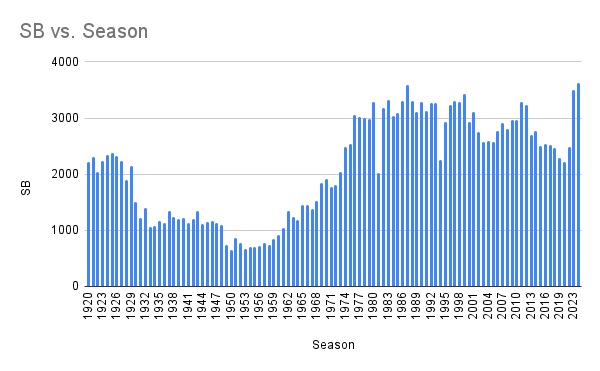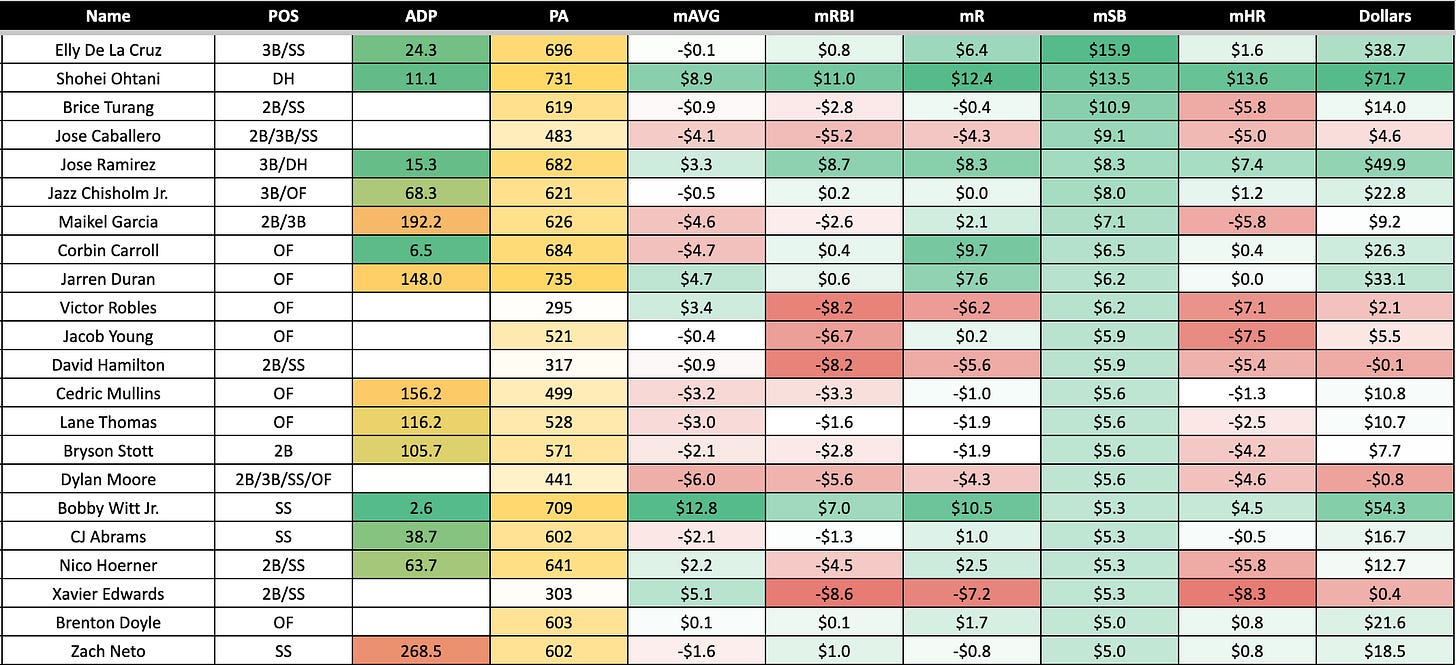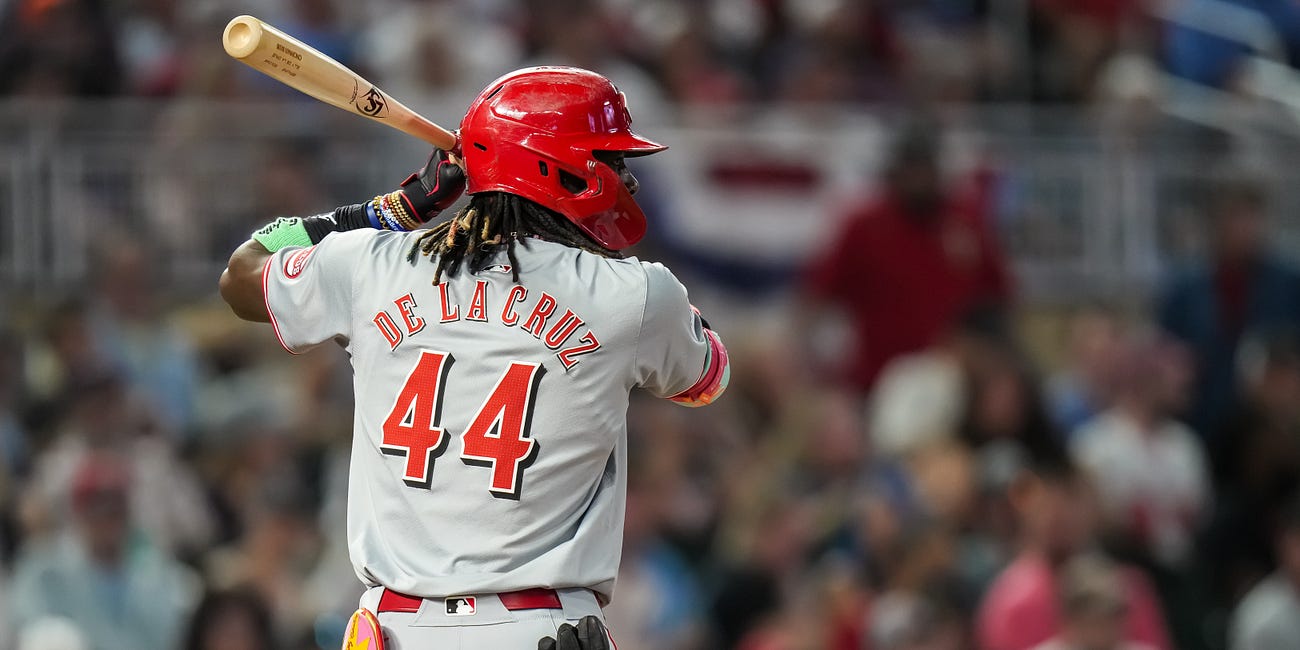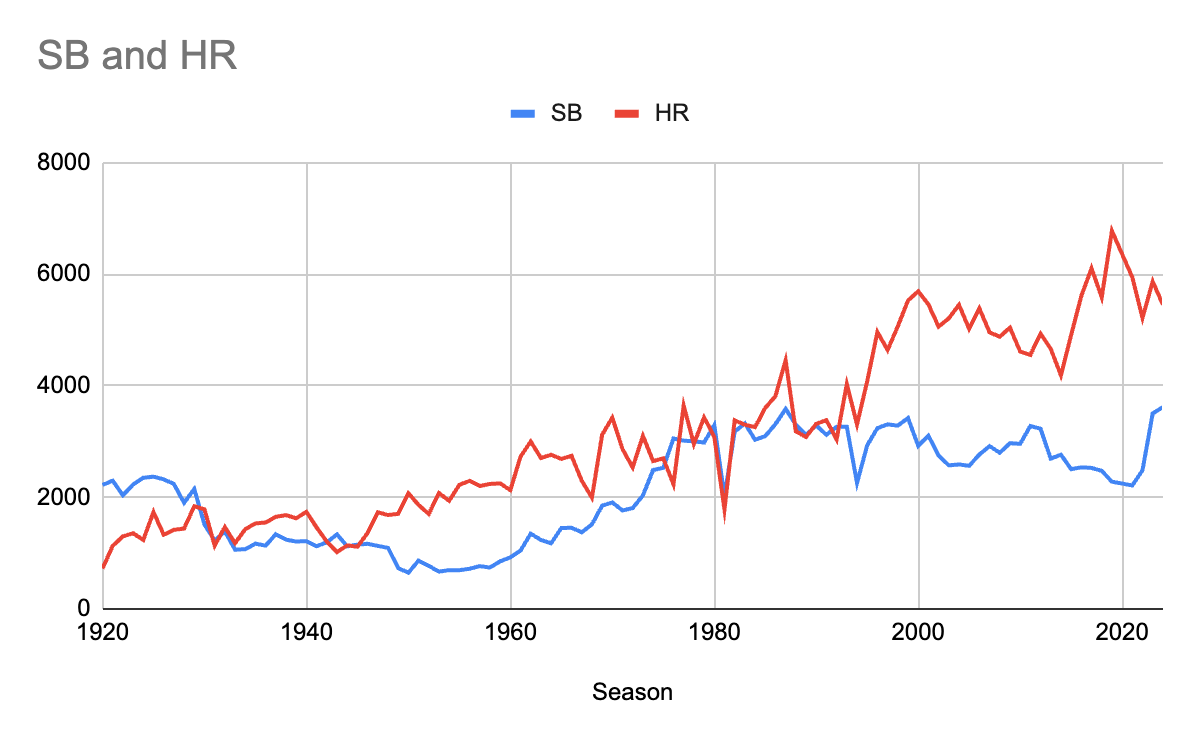MLB's Stolen Base Golden Era Is Here
And how to win 2025 fantasy baseball leagues because of it
Major League Baseball has wanted more stolen bases over the past two years. Thanks to not-so-subtle rule changes, it’s precisely what they’ve gotten.
2023 featured (at the time) the second-highest total for league-wide steals in MLB history, trailing just 1987.
2024 eclipsed them both, which begs the question of how far base stealers will push in the coming years.
Throughout this piece, we’ll be going on a (backward) time-traveling adventure to figure out how we arrived here and what it means for 2025 fantasy baseball strategies.
We start with a visual representation of league-wide stolen base totals dating back to 1920:
There are some caveats, such as expansion increasing the number of teams, but this chart paints a nice picture of league history. The total number of stolen bases in 1921 was higher than in 2019 despite the latter season featuring 14 additional franchises.
By 2022, league-wide, steals were on a gradual decline dating back to the ‘90s.
This was due to several reasons, some of which (like astroturf) will be discussed soon. However, it’s impossible to ignore the impact of Moneyball concepts on the sport. The famous 2002 Oakland A’s ranked dead last in steals that year. They ranked 29th, 28th, and 30th in the following three seasons.
There were still good teams that were aggressive on the bases during these times, but the long-term fallout is apparent—modern front offices were against the idea of risking an out for an additional 90 feet.
This became especially true during the Juiced Ball Era from 2015 to 2021. Risking an out on the bases made even less sense when the next batter was more likely to hit a homer than at any point in the history of the sport:
The shortage of steals during this period caused fantasy players to attempt desperate strategies, such as price-enforcing one-dimensional speedsters like Billy Hamilton, Mallex Smith, and Adalberto Mondesi, to unprecedented degrees.
That’s how starved we were for stolen base sources during this era.
The last time we saw anything close to resembling the recent surge of thefts was (somewhat randomly?).. 2011-12. My best guess for the rise in steals during this stretch was that in a post-steroid league, teams were trying to create offense in other ways.
Twenty hitters stole at least 30 bases in 2011. For comparison, 23 players accomplished the feat in 2024.
Otherwise, big stolen base numbers weren’t present for most of this millennium. Here are the single-season SB leaders since 2000:
Note that three of the top-8 have come in the past two seasons and by three players. We’re dealing with a tiny sample. Still, it’s bullish for future fantasy purposes that ‘23-’24 is seeing a historic number of overall steals and some of the highest single-season totals in recent memory.
The Era of 100 Stolen Bases
We must return to the late 90s before another league-wide peak in stolen bases. 1999 featured the fourth-most stolen bases of the modern era, eclipsed only by ‘24, ‘87, and ‘23.
This decade featured eight individual seasons of 70+ steals, including strike-shortened campaigns in ‘94 and ‘95.
As we zoom out, it becomes clear that this “peak” dates back to 1976.
Our single-season SB leaders from 1976-1999 are fascinating:
There were 15 instances of 80+ thefts. This feat hasn’t been accomplished since Rickey Henderson (93 steals) and Vince Coleman (81) accomplished it in 1988.
The ‘80s also featured the live ball era record for most steals set in a season when Henderson swiped 130 (!!!) in 1982.
Since 1920, 15 of the top 19 SB seasons came in the ‘80s.
The low-scoring era that came before it meant that teams and players were looking to add offensive value differently.
Furthermore, bigger stadiums meant fewer homers, and Astroturf helped the game “play” faster.
Here’s what Baseball America’s Matt Eddy had to say about those years in a column published last season:
“The artificial turf of the old multi-purpose stadiums made basestealing easier, but just as significantly, the faster playing surface placed an emphasis on players with speed and range. Infielders had less reaction time on ground balls as they skittered across the turf, while outfielders needed to be able to cut off balls in the gap to prevent them from rolling to the wall.
This had the effect of teams selecting rangier players at most field positions, and these rangier players tended to steal more bases and advance farther on batted balls that evaded defenders.
Also, in the period before the building boom of the ’90s, ballparks tended to be larger and less homer-friendly. That was another mark against sluggers who didn’t bring speed or defense to the table.
It all added up to an environment that incentivized the stolen base—and that’s exactly what happened in the 1970s, ’80s and ’90s.”
There was more to 1980s baseball than Ozzie Smith vacuuming up grounders across Busch Stadium’s Astroturf infield. Still, it’s always the first image that comes to mind when thinking about this decade in MLB history.
What’s also interesting about the ‘80s is that it's the last time in baseball history that the home run hasn’t been prominently featured. Throughout the game’s history, we’ve seen rises in power output (‘20s, ‘50s, ' 90s) and dips (‘40s, '60s), but it’s been a while since the last downturn—and it doesn’t look like we’re slowing down anytime soon. More on this later.
Here’s another chart that shows where things were at entering the ‘70s.
The rise in steals was a slow build following the 1950s, an underrated time for power in the game. With the emphasis on slugging, teams weren’t as interested in risking an out for an extra base. Sound familiar?
In 1962, Maury Wills became the first player in MLB history to steal 100 bases. This paved the way for Lou Brock to swipe 118 in 1974 and eventually for Henderson and Coleman to do what they did in the ‘80s.
We know what happened next. Smaller ballparks and widespread use of PEDs led to another power boon in the ‘90s — one that has lasted ever since.
By 2021, stolen bases had reached a low point that hadn’t been hit since the strike-shortened 1981 campaign. Even 1994 had more total steals than 2021, despite two fewer teams and without finishing the season. So, stolen bases had hit their nadir. Now they’re back. And more prevalent than ever. So what comes next?
MLB’s Stolen Base Golden Era
There are two key takeaways from this history lesson for fantasy baseball: steals are available in a higher quantity than at any point in the live ball era history of baseball, and some players are combining historic stolen base totals with league-leading power production.
The below graphic shows who compiled the most stolen base value in 2024 via Fangraphs’ auction calculator for Dan Harris’ famous roto league, which I’m lucky enough to play in. This league has contracts and keepers, but the scoring is standard for a 12-team roto format (AVG, HR, RBI, Runs, SB with 5 OF, MI, CI, UTIL, and 9 Ps).
If a player’s ADP cell is blank, their ADP was over 300-ish and therefore could be considered “available late for free” or “available off waivers last some point in-season.”
There’s a lot of blank cells here.
This means that, at least in 2024, steals were attainable after drafts concluded. Were all these players valuable in other aspects of fantasy scoring? No, but this information is helpful when considering a big-picture strategy for 2025.
I don’t have ADPs for 2023, but it’s easy to see how stolen base production aided in the breakouts of Corbin Carroll, Bobby Witt Jr., and CJ Abrams:
Let’s also note the massive totals in the total dollars column on the far right of each screenshot:
Ohtani: $71.7
J-Ram: $49.9
Witt: $54.3
Acuña: $72.3
These are “legendary seasons,” and I’ll write about them more in the lead-up to 2025.
Over the past two seasons, hitters have posted historic HR/SB totals, leading to a rise in legendary hitter seasons.
The above image shows every legendary hitter season since 2013. Eight of the top nine have occurred in the past three years, and four of the top six were in 2024 alone.
This is partly because Aaron Judge is on a hitting rampage we haven’t seen since Barry Bonds. It’s also because the new stolen base rules have led to monstrous fantasy campaigns from Acuña, Ohtani, Witt, and Jo-Ram.
A rise in big HR/SB seasons matters for fantasy. We want to draft those players when we can identify them and attempt to be early on the following power-speed dual threats.
We also want to consider “who will be the next player to swipe 80?”
I have someone in mind who might do that…
Overall, I want to think about steals more than ever in drafts this offseason, but that doesn’t mean taking on the Esteury Ruiz or Victor Scott II profiles. It means chasing the Elly profile—the Jarren Duran profile. Players who can combine league-bending steals totals with enough power/AVG/runs+RBI potential to make a legendary season possible.
Here’s a final way to look at it: In 2024, league-wide stolen bases were at an all-time high. Homers were down compared to 2019 but are still at a relative high compared to MLB's history.
The ‘80s had huge steals totals but not homers. The ‘90s had both, but they weren’t consolidated into one player. For every Mark McGwire, there was a Tony Womack.
In the 2010s, “legendary” fantasy seasons from hitters were few and far between. Of all the macro, big-picture fantasy research I’ve done this offseason, this concept feels most important to me. It will be a vital part of the 2025 Draft Kit/subscription I plan to release in early January.
It’ll all be explained in more detail then, but to sort of preview it, I’ll say that over the past two years, we’ve had more “league-winning” offensive seasons than we have throughout fantasy baseball's recent history prior to the new rule changes.
Judge isn’t just the best power bat today; compared to his era, he’s one of the best ever. Ohtani might be the GOAT. Could Elly steal 70? 80 or more? Who else could go 40-40? Or 20-70?
These are the profiles to chase. The Juiced Ball Era is over, but homers remain prevalent. Now, stolen bases are out there for the taking. We need to chase them, ideally consolidated into one player. Our roto teams need a lot of homers and steals to win it all. The chase to acquire them begins in Round 1.















Thank you for this!
Hey do we like Riley Greene for Semien in a keeper league? Idk anything about the Xzy’s and FIB. It’s a 7x7 league. I have Semien